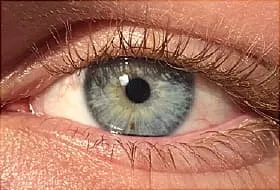Maybe you’ve had a little spot on your eye since you were a kid. Or maybe you just found out you have an eye freckle during a checkup. A freckle in your eye might seem odd, but they’re actually common and usually harmless.
If you have one, your eye doctor may want to watch it over time. It’s rare, but they can turn into a type of cancer called melanoma. So whether they’re old or new, it’s always a good idea to get them checked out.
What Are They?

Some of these nevi (the plural of nevus) are easy to spot. But others are hidden in the back of your eye, where no one but your eye doctor will ever see them. They have different names depending on where they are:
- Conjunctival nevus: On the surface of your eye
- Iris nevus: In the colored part of your eye
- Choroidal nevus: Under your retina (in back of your eye)
Nevi can be yellow, brown, gray, or a combination of colors. They’re made by special cells called melanocytes, which give your skin and your eyes their color. Those cells are usually spread out, but if enough of them clump together, they form a nevus.
The other type of eye freckles are called iris freckles. These are tiny flecks in the colored part of your eye. They’re more like the freckles on your skin than moles -- they’re only on the surface of your eye and don’t affect its shape. About half of all people have iris freckles.
Some types of nevi form before birth, while iris freckles are more likely to show up in older adults.
What Causes Eye Freckles?
Doctors don’t know why some people have them and others don’t, but a couple of things may affect your chances:
- Race: Choroidal nevi -- in the back of your eye -- are much more common in white people or people with lighter skin tones than in black people.
- Sun exposure: It’s possible that sun damage might raise your chances of nevi, and there’s evidence that iris freckles are related to being out in the sun. A 2017 study found that people who spent more time in the sun had more iris freckles.
Do Eye Freckles Need Treatment?
Most don’t -- they’re harmless, just like most moles and freckles on your skin. They’re not likely to affect your vision or cause any problems.
The only reason you might need treatment for an eye freckle is if your doctor thinks it might be a melanoma.
See Your Doctor
If you’ve noticed a spot or freckle in your eye, it’s probably not a problem. But it’s important to get it checked out by an eye doctor (optometrist or an ophthalmologist).
During your appointment, your doctor may want to take a photo of the freckle and possibly do some imaging scans to look at it more closely. You may need to go back every 6 months or so to make sure the freckle hasn’t changed (like growing bigger). If it still looks the same after a few years, you can probably switch to yearly checkups.
Other reasons to see an eye doctor include:
- A freckle in your eye that’s grown or changed its shape or color
- Eye pain
- You see flashing lights
- Other changes in your vision
To protect your eyes, wear sunglasses that block at least 99% of UV rays when you’re outside. While we don’t know for sure, sunglasses might lower the chances that a harmless nevus will turn into melanoma. And they definitely lower your odds of getting cataracts and other serious eye problems.

